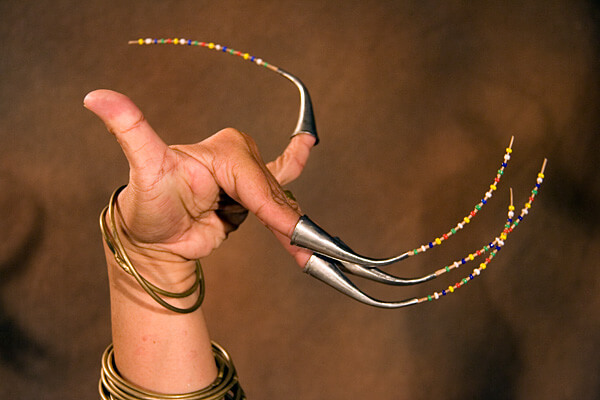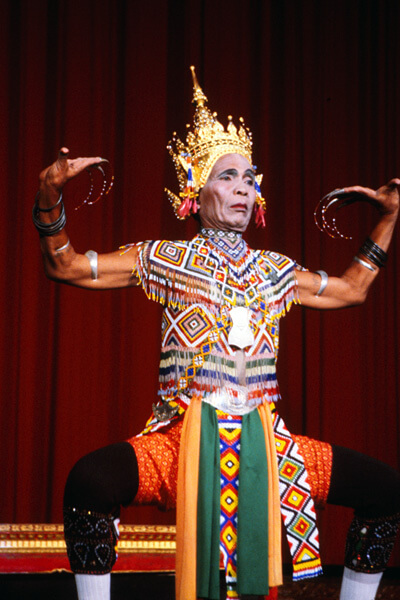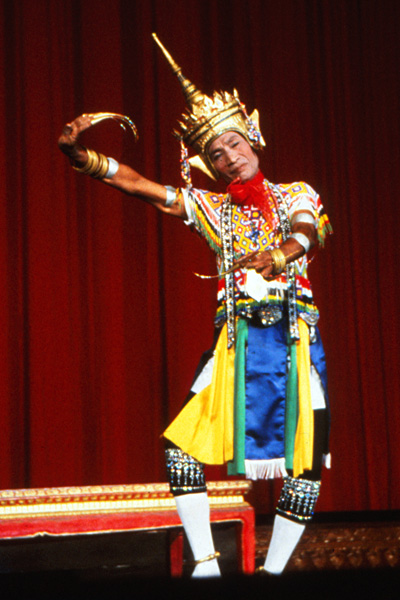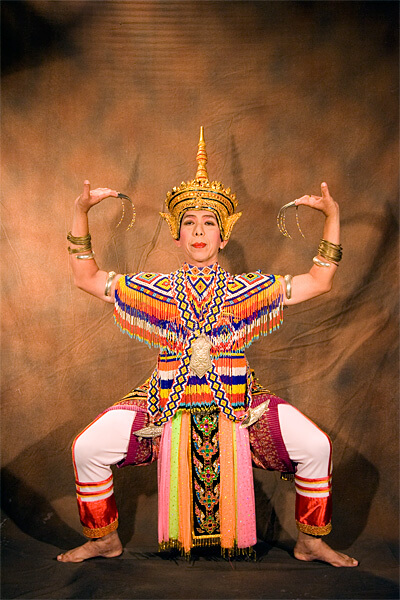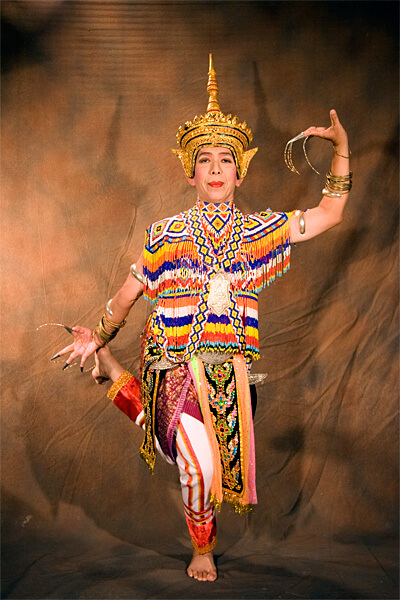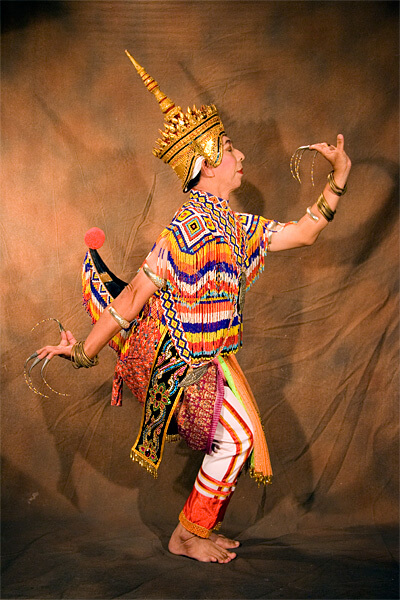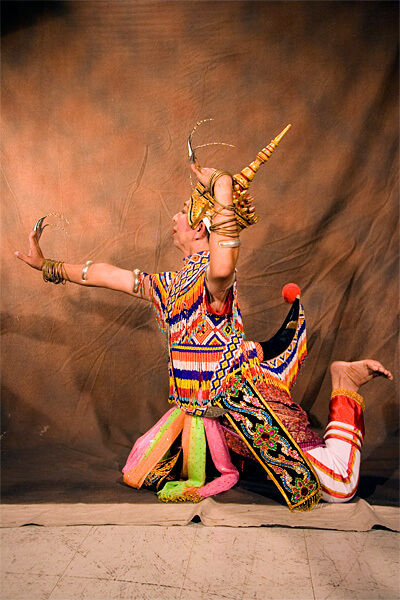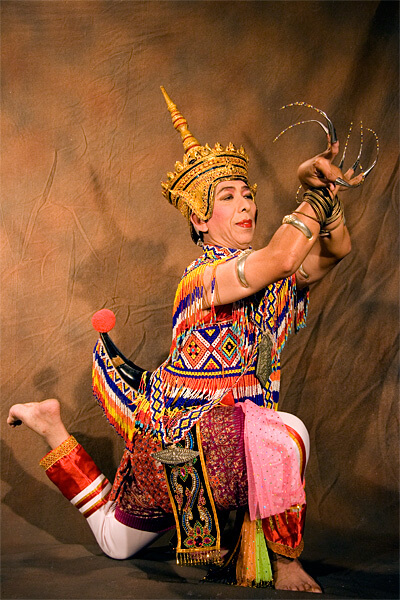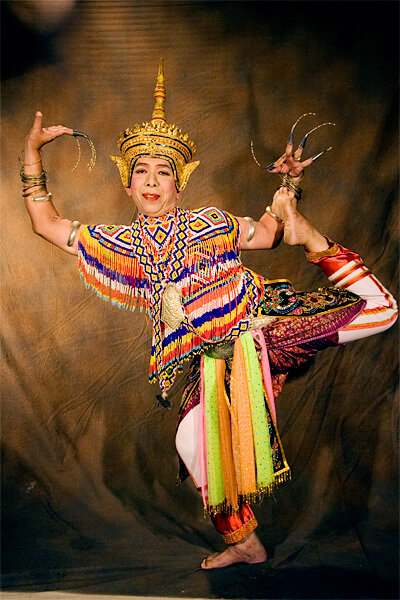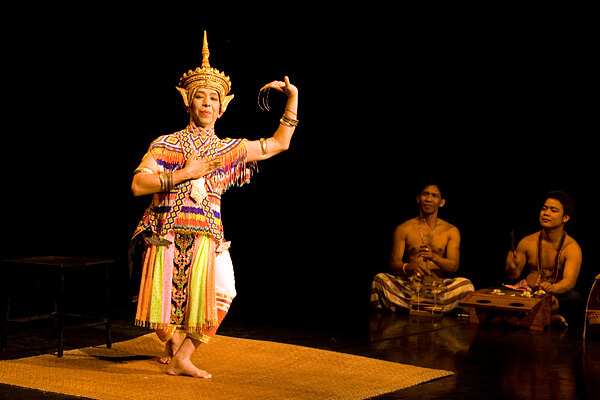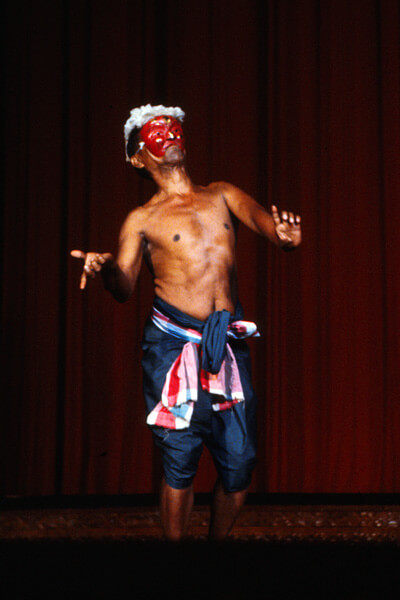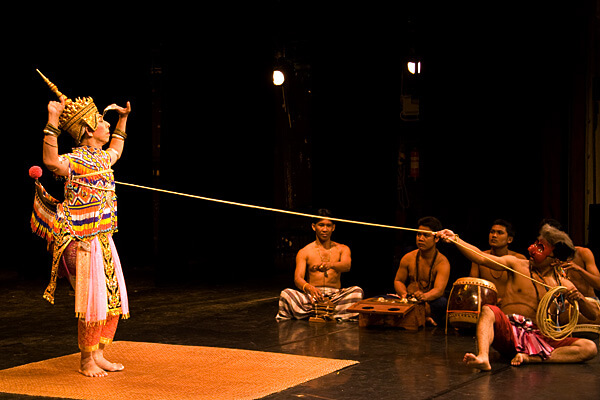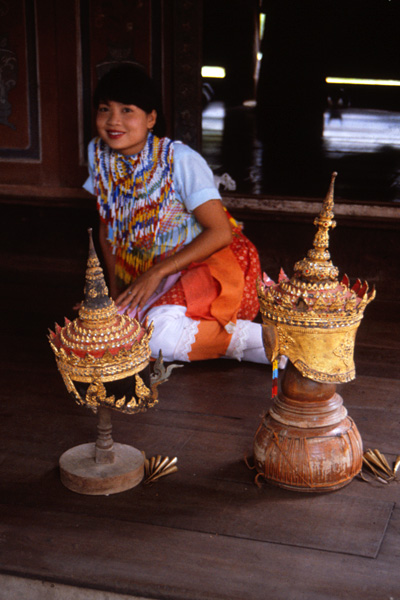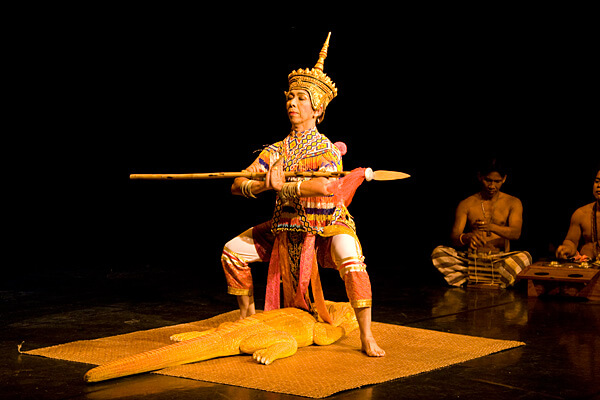Nora, Archaic Dance-Drama
- Long, artificial nails, decorated with glass beads, form an important element of the nora dance Jukka O. Miettinen
- Long, artificial nails of the nora dance Jukka O. Miettinen
Nora is a form of dance-drama performed mainly in the southernmost provinces of Thailand and the northern parts of Malaysia. The name nora is a shortened form of the name Manora, the standard heroine of an ancient tale, which often serves as the plot material for this type of dance-drama. The genre is also known as lakhon nora, nora chatri, manora, or menora. Traditionally, nora has been interwoven with elements of ancestor worship and spirit possession while it is also, at the same time, a complex form of dance-drama. Performances dominated by the ritual elements are often called “ancient nora” while the more entertaining performances are called “modern nora”.
Origins
- A nora master of older times Jukka O. Miettinen
Nora has its own music tradition; its language is a Southern Thai dialect; its movement techniques appear to have come almost directly from far-off India; and it has an undeniable magical character. Its origin has been the subject of much speculation. According to one theory, it is the link between the ancient theatrical forms of the Malay Peninsula and the lakhon of Central Thailand, and possibly the basic form of the other lakhon types.
- A nora master of older times Jukka O. Miettinen
- A nora master of older times Jukka O. Miettinen
It has also been claimed that nora separated from the Central Thai tradition at an early stage, developing in isolation. It seems to be clear, however, that nora is a result of cultural contacts with Sri Lanka and/or India. This is supported by the fact that its dance poses include direct loans from early Indian dance as well as Sri Lankan dance. Furthermore, South Thailand, where nora is still flourishing, was the crossroads of ancient sea trade routes which connected the area with India as well as with Sri Lanka, from where Theravada Buddhism was adopted in Thailand.
Whatever its origin, nora is a unique theatre tradition in its inimitability and expressiveness. It is an embodiment of the complex syncretistic belief system of the region where it is performed. Its ritual elements reflect the local animism, its central plot material is derived from Buddhist lore, and its movement technique is related to the Indian Hindu tradition, while the tradition is now thriving in predominantly Muslim communities.
Animal Movements and Indian Influence
- Achan Thammanit, a present-day nora master, demonstrates some of the basic poses of nora dance Jukka O. Miettinen
- Achan Thammanit, a present-day nora master, demonstrates some of the basic poses of nora dance Jukka O. Miettinen
- Achan Thammanit, a present-day nora master, demonstrates some of the basic poses of nora dance Jukka O. Miettinen
- Achan Thammanit, a present-day nora master, demonstrates some of the basic poses of nora dance Jukka O. Miettinen
- Achan Thammanit, a present-day nora master, demonstrates some of the basic poses of nora dance Jukka O. Miettinen
- Achan Thammanit, a present-day nora master, demonstrates some of the basic poses of nora dance Jukka O. Miettinen
- Achan Thammanit, a present-day nora master, demonstrates some of the basic poses of nora dance Jukka O. Miettinen
- Achan Thammanit, a present-day nora master, demonstrates some of the basic poses of nora dance Jukka O. Miettinen
The southern nora is stylistically quite different from the other forms of dance-drama, which developed mainly in Central Thailand. Its dance style stresses angular movements, very open leg positions, and extremely expressive finger movements emphasised with long detachable fingernails decorated with beads. The technique includes a unique way of moving by sliding the feet instead of walking.
Video clip: nora ritual dance Veli Rosenberg
Many of the basic poses of nora are named after various animals, which may indicate their archaic roots in the ancient animal movements. The music and movement techniques have a strong Malay-Indian flavour, and the characteristic, demanding acrobatic poses have preserved ancient Indian dance poses (karana) that disappeared from India centuries ago. Nora groups originally consisted of only three male actors, but today women may also become nora stars, and groups often include several members.
The Story of the Heavenly Maiden
- The comic, yet evil, hunter, Phra Bhun of the Manora story with his red half-mask Jukka O. Miettinen
- Phra Bhun catches Manora Jukka O. Miettinen
The standard plots of nora plays were derived from two sources: the Ratsen and the Manora, of which the latter has been more popular. It tells of a supernatural kinnari (half-bird and half-human) princess called Manora, who, like other kinnari, lives on the mountain-tops in the Himalayas. One day a hunter, Phra Bhun, sees Manora and her sisters bathing, and is struck by her beauty.
The hunter steals her wings and tail, and takes the maiden to a palace, where the crown prince falls in love with her and marries her. The prince, however, has to go off to war, and an evil minister convinces the king that Manora must be burned in order to save the king’s life. Manora is placed on the pyre, but at the same moment she regains her wings and flies back to her heavenly kingdom. After many trials, the prince acquires supernatural powers, and is allowed to enter the kingdom of the kinnari and rejoin his loved one.
The tale of Manora is also known in Central Thailand, where it developed into a classical dance-drama, as well as in Cambodia, Burma, Malaysia, and Indonesia. Manora was originally a Buddhist Jataka story, and the prince is actually the Buddha in one of his earlier incarnations. However, almost similar kinds of stories are known in several Asian cultures.
The story is rather complex, and it requires many evenings to be completely presented. In practice, the story is used only as a binding theme, and the whole performance includes prayers, dance numbers, obscene verbal humour, folk comedy elements, and sometimes magic rituals intended, for example, to bring bad luck upon some rival theatre group. The nora dancers have traditionally had an aura of magic about them, which may refer back to the roots of the genre as a kind of shamanistic healing or possession ritual.
Birds’ Tails and Golden Crowns
- A young dancer and nora crowns Jukka O. Miettinen
Nowadays, the standard costume of the nora dancers consists of shin-length trousers, a bodice of bright, woven glass beads, and a heavy, tapering gilded crown. A distinctive feature is a bird’s tail or wing-like extension in the back of the costume, which probably derives from the half-bird kinnari of the Manora story. Phra Bhun, the clown character, dances in a relaxed manner in a white loincloth, with a grotesque, red half-mask leaving the mouth free for his lines. Nora was originally performed outdoors without props or sets. At present, the touring troupes usually hang a painted backdrop with illusionistic scenery behind their small stage.
- Stabbing the crocodile is a standard nora number Jukka O. Miettinen
- Stabbing the crocodile is a standard nora number Jukka O. Miettinen
Nora is being preserved as part of the cultural heritage peculiar to South Thailand, which, except for occasional performances in Bangkok, is the place to see nora. All forms of nora are still being performed: the ritualistic “ancient” variation and the dance-drama form. The nora repertoire includes several dance numbers, which are often performed without the dramatic context, such as Hooking the Swan and Stabbing the Crocodile.
- Nora as a group dance Jukka O. Miettinen
In recent decades nora has become increasingly popular and nora dances are often performed by large groups of dancers both in the south as well as elsewhere in Thailand. Popular forms have also evolved, such as nora karaoke and rock nora. Thus nora has become a kind of trademark of southern Thai culture. It was included in UNESCO list of the Intangible Cultural Heritage of Humanity in 2021.

